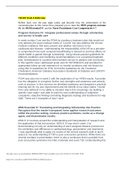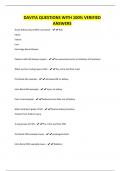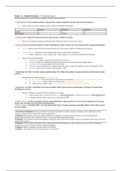Financial management Lecture Summary
Lecture 1 Financial Statements & Capital budgeting
Financial Management
- Involves planning, directing, monitoring, organizing and controlling of the monetary
resources of an organization
- Is geared towards achieving the organization’s goals and objectives
- Wil have severe repercussions on the organization’s growth and development, if not properly
dealt with.
Sub disciplines
Finance
= the selection of assets in which to invest. An asset is anything tangible or intangible that is held to
have positive economic value (e.g. buildings, machines…) fixed vs. current assets
How these assets are financed
Topics: capital budgeting, working capital management, assessment of the financial structure
Accounting
Management accounting = provision of financial information to the management. Purpose is to
support management in the decision-making process (internal reporting)
Overview of the costs involved in running the business.
Report on whether or not the project or organisation is performing according to expectations
and where interventions are needed
Topics: cost structure, cost calculations, budgeting and variance analysis
Financial accounting = disclosure of information by the organization’s management to other
stakeholders such as shareholders, employees, credit providers, governments (externa reporting)
Topics: financial accounting, financial statements
Balance Sheet = snapshot of the financial situation at a specified time point
T-format
o Debit side : investments (assets)
o Credit side: financial resources (liabilities, equity)
,Balance: total value debit = total value credit
Assets: resources required for running the organization. Must be controlled by the organization. Is
expected to generate economic benefits for the organization.
Fixed/ non-current assets: longer than 1 year >
Current (working capital): shorter than 1 year <
Liabilities = capital made available by creditors
- Debts: long-term (bank loans) or short-term (current liabilities, accounts payable)
- Provisions
Equity = capital made available by owners
Residual item:
Equity = assets – liabilities
Change in equity over a period = profit/ loss
Income statement: profit & loss account
Components
o Revenues (turnover)
do not always coincide with cash inflows. Are booked at the moment of delivery and invoicing
or services (regardless of moment of payment)
o Costs (expenses)
Do not always coincide with cash outflows (e.g. depreciation). Are assigned based on period
or product matching.
o Profit (net income)
= difference between revenues and costs
, Capital budgeting (investment appraisal)
= the process in which an organization determines whether investments are worth pursuing
Assessing whether it is worthwhile to invest in a particular project & choosing between different
projects
Two types of investments: replacement vs. expansion investments
Free cash flow vs. profit
Free cash flow
- Cash inflows (receipts), generated by sales and other income directly resulting from the
investment.
- Cash outflows (expenses), generated by purchasing of resources related to the investment,
rent, corporate taxes
Includes initial investment and disinvestment
Residual value of the investment
Period profit (accounting income, net income) = difference between period sales/ income and costs
associated with an investment
Lecture 1 Financial Statements & Capital budgeting
Financial Management
- Involves planning, directing, monitoring, organizing and controlling of the monetary
resources of an organization
- Is geared towards achieving the organization’s goals and objectives
- Wil have severe repercussions on the organization’s growth and development, if not properly
dealt with.
Sub disciplines
Finance
= the selection of assets in which to invest. An asset is anything tangible or intangible that is held to
have positive economic value (e.g. buildings, machines…) fixed vs. current assets
How these assets are financed
Topics: capital budgeting, working capital management, assessment of the financial structure
Accounting
Management accounting = provision of financial information to the management. Purpose is to
support management in the decision-making process (internal reporting)
Overview of the costs involved in running the business.
Report on whether or not the project or organisation is performing according to expectations
and where interventions are needed
Topics: cost structure, cost calculations, budgeting and variance analysis
Financial accounting = disclosure of information by the organization’s management to other
stakeholders such as shareholders, employees, credit providers, governments (externa reporting)
Topics: financial accounting, financial statements
Balance Sheet = snapshot of the financial situation at a specified time point
T-format
o Debit side : investments (assets)
o Credit side: financial resources (liabilities, equity)
,Balance: total value debit = total value credit
Assets: resources required for running the organization. Must be controlled by the organization. Is
expected to generate economic benefits for the organization.
Fixed/ non-current assets: longer than 1 year >
Current (working capital): shorter than 1 year <
Liabilities = capital made available by creditors
- Debts: long-term (bank loans) or short-term (current liabilities, accounts payable)
- Provisions
Equity = capital made available by owners
Residual item:
Equity = assets – liabilities
Change in equity over a period = profit/ loss
Income statement: profit & loss account
Components
o Revenues (turnover)
do not always coincide with cash inflows. Are booked at the moment of delivery and invoicing
or services (regardless of moment of payment)
o Costs (expenses)
Do not always coincide with cash outflows (e.g. depreciation). Are assigned based on period
or product matching.
o Profit (net income)
= difference between revenues and costs
, Capital budgeting (investment appraisal)
= the process in which an organization determines whether investments are worth pursuing
Assessing whether it is worthwhile to invest in a particular project & choosing between different
projects
Two types of investments: replacement vs. expansion investments
Free cash flow vs. profit
Free cash flow
- Cash inflows (receipts), generated by sales and other income directly resulting from the
investment.
- Cash outflows (expenses), generated by purchasing of resources related to the investment,
rent, corporate taxes
Includes initial investment and disinvestment
Residual value of the investment
Period profit (accounting income, net income) = difference between period sales/ income and costs
associated with an investment










